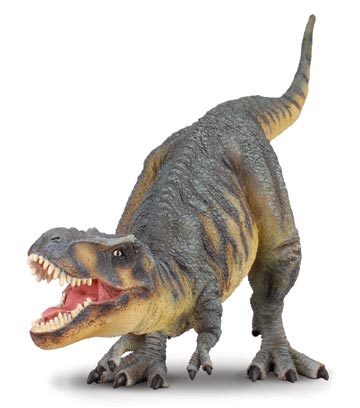Heads Up or Should that Be Heads Down for Tyrannosaurs
Tyrannosaur Head Position in Dinosaur Models
When working on bipedal dinosaur models, often the focus from a design point of view is achieving a stable prototype from which to work with. These ornithodirans can be a little tricky when it comes to the Theropoda, their bipedal stance causes all sorts of problems, after all, a 6,000 kilogramme T. rex walking on its hind legs is impressive, and you want to make an accurate representation of the creature, so the stance and position of the hind feet are all important.
As digitigrades (walking on their toes as opposed to walking on their heels), theropods such as T. rex are certainly a challenge, just producing a workable, realistic prototype. Then with T. rex there is another dimension to consider – their massive skulls.
Such a heavy head, positioned at the front of the animal model, compounds the balance issue, especially when a considerable portion of the weight of the replica is located far away from the centre of gravity over the hips, and, as in the case of T. rex often the head is elevated and becomes the highest part of any model.
One way of resolving this issue, is to take a novel approach to the head position and depict the tyrannosaur with a lowered head. An example would be the CollectA 1:15 scale and 1:40 scale Tyrannosaurus rex replicas.
A Picture of the CollectA 1:40 Scale Model T. rex
To view the CollectA Deluxe dinosaurs range: CollectA Deluxe Prehistoric Life Models.
In this model, the head is depicted in lowered position, jaws agape. The tail is elevated and becomes the highest part of the replica. Balance is not just the only consideration though, this type of stance may reflect typical behaviour of large carnivores as they attempt to intimidate rivals and prey.
Having your main weapons perched some fifteen feet in the air is not much good when confronting a quadrupedal ankylosaur. One look at that powerful jaw lined with huge teeth may have been enough to stop a herbivore in its tracks. Such intimidation may have been used before this carnivore attacked.
Many birds display by “head bobbing” and it is feasible that T. rexes displayed as well. Visual cues would have played a role in any such behaviour, the dipping and bobbing of heads, perhaps to show the size of the mouth and the gaping jaws would have been an effective way of settling disputes over territory or mates.
So a pose in a model of a bipedal dinosaur may actually serve two purposes, firstly to stabilise the replica and secondly to depict suggested behaviour. Sorting of “killing two birds with one stone” – looks like we are back to the ornithodirans again.


